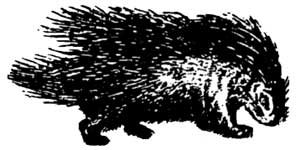|
Volume XXVI - 1995
The Fretful Porcupine
By Marianne Mills
Measuring up to 2.5 feet in length and weighing thirty pounds, the
North American porcupine, Erethizon dorsatum, is one of the
world's largest rodents. Fossils of porcupine ancestors date back to the
Oligocene epoch, about 30 million years ago. It is believed that
porcupines originated in South America and are most closely related to
the guinea pig and the chinchilla. While porcupines may not be
considered great beauties of the natural world, they have proven
themselves to be masters of survival. Naturalist Uldis Roze describes
them as "a microcosm in the great evolutionary adventure of nature."
Dark in color, they have a somewhat "frosted" appearance because
their quills are yellow to white with a black tip. An average of 30,000
quills grow only on their backs, sides, and tails. These modified hairs
have tiny scales like a fish, with each scale acting like a tiny barb on
a fish hook. It is these scales that hold a quill tightly in a
predator's skin. Folklore describes a creature that is quick to fire
quills at enemies. In truth, it slaps its victims with its tail only in
self-defense and does not have the ability to project its quills, no
matter how frightened. Muscle action combines with these scales to work
the quills deeper and deeper into the unfortunate's body, becoming very
painful. If a vital organ is struck, they can be fatal. A misconception
is that a quill will shrink if the end is cut off, making it easier to
pull out. The quills are filled with a spongy material, not air, so they
do not shrink or soften.
The range of porcupines covers most of the western United States.
Their preferred habitat is dense forest, making Crater Lake National
Park suitable for a healthy porcupine population. Slow and somewhat
awkward, these nocturnal creatures are more graceful in trees than on
the ground. They always climb up head first, but will back down a tree
tail first. Much of their time is spent in a den which is usually a
small cave or deep crevice in a ledge or rock pile, a large hollow in a
tree trunk a hollow under a partially uprooted tree, or an abandoned
animal burrow. In very cold weather or deep snow, porcupines sometimes
stay in their dens for two to three days at a time. Solitary during most
of the year, porcupines may band together to share a den and their
communal heat. If a porcupine is seen out of its den in winter, it is
most likely there to feed, then return to warmth. Possessing some of the
poorest eyesight among all mammals, a typical porcupine can see only two
to five feet in the distance. Poor vision is offset by excellent senses
of smell and hearing. Porcupines vocalize; if disturbed, they may
squeak, grumble, groan, or seem to mutter to themselves. They can also
emit a high-pitched cry that people have mistaken for a bobcat or
mountain lion.
Most often found between 5,000 and 6,500 feet in elevation,
porcupines are strict vegetarians. Their favorite food is the inner bark
of trees, though they tend to feed on young trees that would most likely
be naturally shinned out. They also like leaves, certain grasses,
berries, and fruits such as apples. They possess an insatiable love of
salt, something which causes them to frequently loiter around highways
which get salted during winter. This can lead to the death of many
porcupines through being struck by vehicles. Porcupines are also drawn
to objects that people have handled so as to lick the salty sweat left
behind. Their search for sodium can thereby bring about the destruction
of objects such as handrails, steps, and doorways.
Porcupines are somewhat different than most mammals in that the
females stake out a territory and fight to protect it, rather than the
males. A female porcupine has just one offspring per year and will raise
it alone. Baby porcupines are called porcupettes and are comparatively
large, being about one pound at birth. They are born with open eyes and
soft quills, with the latter hardening within the first ten minutes
after delivery. Porcupettes will travel long distances on their own
almost immediately, but they do not climb trees for several months. The
young porcupettes travel with their mother during night feeding sessions
for three to four months when they become independent.
When thinking of the great animals of literature, seldom does the
porcupine come to mind. The title of this article is taken from Act I,
Scene V of Hamlet and reminds us that all creatures have a place in art,
as well as science: "I could a tale unfold whose lightest word Would
harrow up thy soul . . . Like quills upon the fretful porpentine { sic }
. " A naturalist must also exhibit duality, or lives in two worlds: the
world of nature and the world of human ideas. One world is represented
by a fallen tree; the other by a library. Each species studied, each
theory formed brings the two worlds a bit closer together. We learn
through the survivors and speculate on species that have become extinct.
The porcupine thus becomes a storyteller of the woods. In its telling,
its frets are fewer and its ancient story more eloquent.
Further Information
Uldis Roze, The North American
Porcupine. Washington, DC: Smithsonian Institution Press, 1989.
Marianne Mills was the assistant chief of interpretation at
Crater Lake until May 1995, when she transferred to Badlands National
Park.

|

